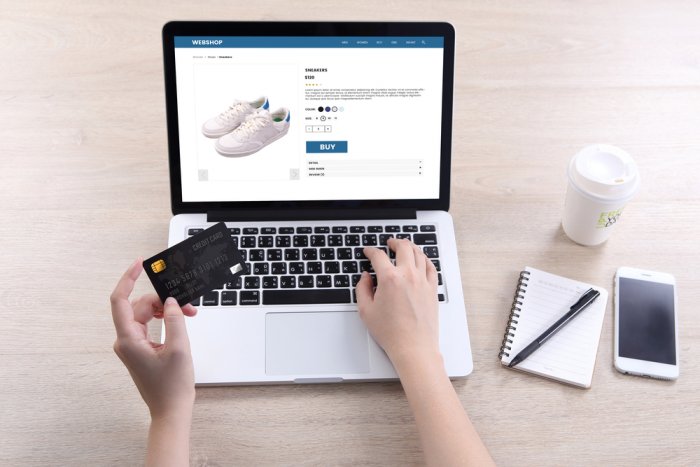Online FMCGs Reap Fruit of Pandemic’s Disruption

Krisztina Hittner, PR team leader of DM Drogerie Markt Kft.
While the pandemic restructured every industry, the online shopping segment of the fast-moving consumer goods sector has surfaced as a significant beneficiary as lockdowns and restrictions sparked new consumer habits. The Budapest Business Journal explores how the market has evolved.
“E-commerce was just an option before the pandemic. But it rapidly became the only solution for many people [when the pandemic broke out], and markets had to catch up with its speed,” Krisztina Hittner, PR team leader of DM Drogerie Markt Kft., tells the BBJ.
Infrastructure had been ready for some, even before the pandemic. The Hungarian business of U.K.-based retail giant Tesco was among the first here to launch its online shopping experience in 2013. Back then, adoption was slow. However, what used to be a market rarity has become a must, necessitated by the COVID disruption.
“Online grocery shopping at Tesco achieved single-digit growth before the COVID crisis when customers benefited from it for their bigger weekly shopping. The pandemic saw us reach our three-year goal, set at the beginning of 2020, in a year, as online sales doubled, sometimes tripled, compared to the previous year’s performance,” Nóra Hevesi, head of communications and campaigns at Tesco Hungary, says.
The “new normal” significantly lifted online sales across the industry.
“During the pandemic, customers turned to other shopping options to reduce the risk of getting ill. It caused a high peak of orders and basket size. After this peak, the number of orders fell back a bit but kept a constant growth,” explains Miklós Czeglédi, digital director of Auchan Hungary.
The ease, comfort and safety of online shopping resonated well with the masses, many of whom tried it for the first time during the pandemic. The continued high numbers for online orders show that people have stuck with this shopping approach even after the outbreak. But there is more to the service. Quality is essential.
“It is easy to attract and acquire new customers, but the real challenge is to keep them and make them loyal to your service. If you fail to deliver what they ordered or your delivery has poor quality, you will lose them faster than you got them,” Czeglédi warns.
Increased Popularity
The increased popularity of online shopping has changed how deliveries operate too. A few years earlier, online grocery shopping was such a novelty that two-to-three- or even five-to-six-day-long delivery windows used to be acceptable in the industry.
“With the digital transformation and globalization, expectations are higher than ever regarding the delivery time. With the appearance of quick-commerce, a 20-to-30-minute delivery is a real challenge for all players on the online grocery market,” Czeglédi says.
Although shopper frequency in brick and mortar stores is recovering today, the high share of e-commerce remains solid.
“Therefore, online shop solutions have developed rapidly, such as our services,” DM’s Hittner says. “We introduced fast delivery, which means within three hours [from placing an order], customers can collect their order in their chosen store. We also linked our loyalty program with our online store; therefore, online customers can also enjoy its benefits.”
Online grocery shopping also reflects some new shopping trends, as Czeglédi of Auchan explains.
“Conscious eating and nutrition are trending, which means healthy food from organic sources without any chemicals. Also, veganism is popular,” he says.

Miklós Czeglédi, digital director of Auchan Hungary.
More Sensitive
People are becoming more sensitive to environmental issues. They demand products free of packaging and with less waste during and after delivery of their orders.
“It is also a very important topic for us because Auchan is truly committed to the environment. As proof of this, we are constantly eliminating plastic shopping bags starting from the beginning of this year,” Czeglédi adds.
Tesco says it is adopting a similar approach. “Sustainability is at the core of our activities, encouraging us to switch to green alternatives wherever it is possible,” Hevesi says. “Bagless delivery is a new default option on the Tesco Home platform to avoid the use of shopping bags and deliver products in crates. Unless customers opt-out when they order, no bags will be used other than those mandatory for hygiene reasons,” she adds.
Despite the online shopping boom, Hungary has room for improvement in this regard compared to its three Visegrád Four peers, the Czech Republic, Poland and Slovakia.
“According to the Europe E-commerce Report 2021, the growth of e-commerce in Hungary was the highest, just a bit ahead of Poland, followed by the Czech Republic and Slovakia,” Czeglédi notes. “However, the total turnover from this channel is lowest in Hungary, after Slovakia. If we look at the Czech market, which is six times bigger in turnover than Hungary’s, there still is a huge opportunity for us to grow,” he adds.
Trends point towards an optimistic future, however. Online FMCG sales grew by almost 45% in the first nine months of 2021 in Hungary, according to the GKI Digital “Online Retail Big Picture,” a representative survey.
This growth propelled FMCG to become the quickest growing online retail segment in the first three quarters of 2021. During the previous year, the total revenue of online FMCG sales exceeded gross HUF 110 billion, according to a press release issued at the end of January by eMAG. The online retailer was the most popular platform for FMCG purchases in 2021, according to the GKI survey.
The average basket value for online FMCG purchases approached gross HUF 21,000 in 2021, which is more than 10% of the monthly Hungarian minimum wage recorded on Jan. 1, 2022, according to data from the Central Statistical Office. The figures, and industry sentiment, paint a bright, bustling future for online FMCG shopping.
“E-commerce will remain important and keep growing. The quintessence of DM commerce will stay the same, though: personalized care and advice to our customers,” Hittner says.
This sentiment is echoed in Tesco’s vision, too. “Further expanding our online business channels is a priority for us this year, responding to customers’ need for a fast and smooth shopping experience,” Hevesi concludes.
This article was first published in the Budapest Business Journal print issue of February 11, 2022.
SUPPORT THE BUDAPEST BUSINESS JOURNAL
Producing journalism that is worthy of the name is a costly business. For 27 years, the publishers, editors and reporters of the Budapest Business Journal have striven to bring you business news that works, information that you can trust, that is factual, accurate and presented without fear or favor.
Newspaper organizations across the globe have struggled to find a business model that allows them to continue to excel, without compromising their ability to perform. Most recently, some have experimented with the idea of involving their most important stakeholders, their readers.
We would like to offer that same opportunity to our readers. We would like to invite you to help us deliver the quality business journalism you require. Hit our Support the BBJ button and you can choose the how much and how often you send us your contributions.









